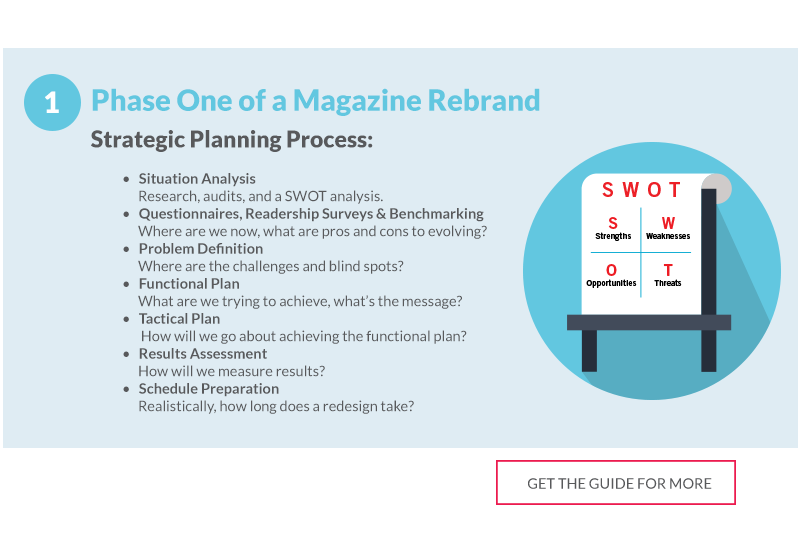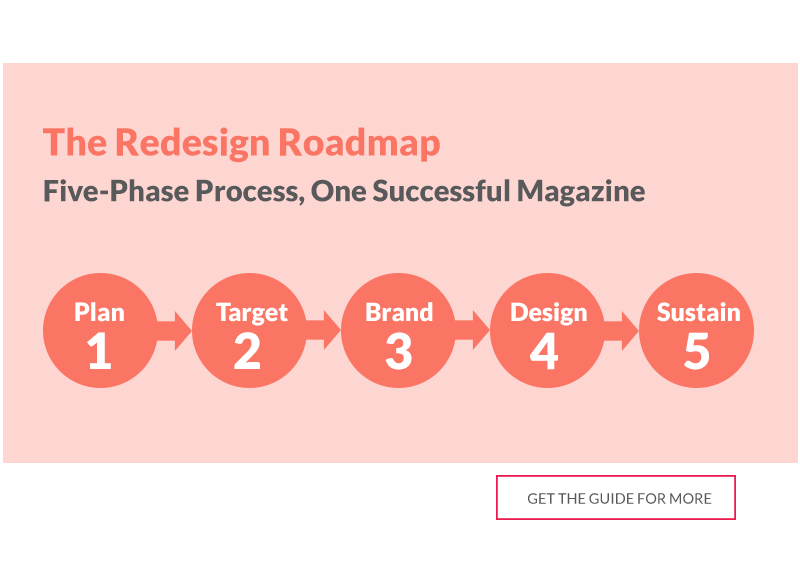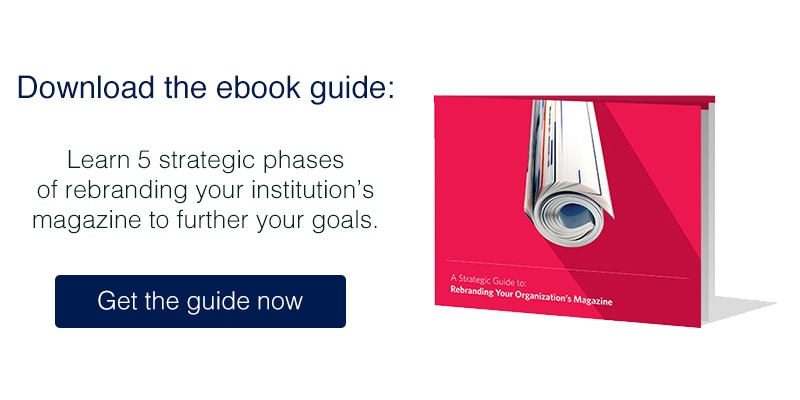When (and Why) Is It Time For a Magazine Redesign?
June 20, 2017 at 4:08 PM

An American icon of graphic design, Milton Glaser, said "There are three responses to a piece of design yes,' no,' and wow.' Wow' is the one to aim for."
Magazines are hard work. Given all the time and effort you put into yours, you want it to wow your readers.
Perhaps you have a vague suspicion that your organization's magazine isn't wowing readers anymore it's feeling outdated, or your readers' demographics and therefore interests are changing, or maybe you've just seen a stunning magazine example that you can't stop thinking about and are feeling inspired. Perhaps you've wanted to redesign for some time but need help convincing stakeholders that it's worth the budget.
With decades of experience in magazine design across a variety of industries, from creating templates and style guides to full issue-to-issue content management, we at NeigerDesign have seen a lot of different situations surrounding a redesign or a rebranding (we even made an ebook guide about it: Rebranding Your Organization's Magazine).
Read on to understand some of the top reasons organizations decide to redesign, how to know when the time is right, and even ways to convince your stakeholders that it's time to move forward.
Top Reasons Why
So, why do you think your magazine needs a redesign?
Despite (or sometimes because of) how well you know your magazine inside and out, this question can throw people off course. It may simply feel like it's time for an update, or there may be multiple factors.
We always encourage taking a step back to look at the bigger picture, and to really consider the why of the redesign.
Among the most common reasons for a magazine redesign are these:
- You have had the same design for at least 5 years
- You've hired a new editor
- You want to reach a new or broader audience
- Your technological or cultural advances have altered editorial content
- Your editorial and creative team feels bored, are repeating themes or are having difficulty fitting new ideas into the current format of your magazine
- Your design and brand is straight-up outdated
Be wary of change just for the sake of change, but keep in mind that there are some legitimate reasons that a change in leadership or staffing might initiate a redesign. For example: if the new editor has a strategic plan for engaging and growing readership that requires a shift in content that should be complemented by the design.
It's also possible that minor changes and design "tweaks" over time have altered your magazine to the point when it's time to reassess whether or not it's still a cohesive, coherent design.
Of course, if your magazine is no longer serving your mission, then that is the only "why" you need.
The important detail here is that the choice to redesign should be strategic.
Analyze Your Situation
Even if there's a clear consensus that it's time to redesign, there is much insight to be gained by doing a proper situation analysis. Fortunately, the effort you put into a bit of analysis now will lay the foundation for redesigning your new and improved magazine later.
In fact, planning is the first phase of the magazine redesign process. Think of the research and analysis you're doing now as a head start on the process to come and, trust us, you won't regret taking the time to assess your magazine and audience.
As a strategic marketing company, we'd be remiss if we didn't suggest a SWOT analysis for creating a more detailed outline of what is and isn't working with your current publication.
For the uninitiated, a SWOT analysis is a framework for examining your strengths, weaknesses, opportunities, and threats. It's a great way to organize your magazine team's thoughts.
Keep in mind, you'll need to be honest which means being critical when sharing your perceptions, to make the case for change.
SWOT Analysis Quick Tips
A SWOT analysis can be an effective, yet simple, strategy tool to kickstart your planning.
Traditionally a matrix, the SWOT analysis is easy to organize. Create quadrants for each of the elements: strengths, weaknesses, opportunities, threats.
The strengths and weaknesses of your magazine are primarily internal to your organization, but be sure you keep your audience in mind when you're identifying these.
Opportunities and threats, on the other hand, are primarily external and based more on the environment or market for your organization and magazine.
Some questions to jump-start your analysis:
- Strengths
a. What advantages does your magazine have?
b. What do your readers consider your strengths?
c. What do you do better than anyone else?
d. What are your resources (personnel, financial, etc.)?
e. Do you have experiences, or a good reputation, that are strengths? - Weaknesses
a. Are you lacking in any resources?
b. What are likely negative perceptions of your magazine or brand?
c. What needs improving?
d. What don't you do as well as other magazines? - Opportunities
a. Are there potential avenues for growing your resources?
b. Have the demographics of your largest audience group changed?
c. Consider if your organization has access to any new technology you could capitalize on for your magazine.
d. What are new trends you could pursue? - Threats
a. Is there any fluctuation or unpredictability in your funding?
b. What could detract from your magazine among your readers (attention, perception, etc.)?
c. Are any of the weaknesses you identified potentially serious threats to your organization?
d. Consider additional obstacles (such as increases in printing costs, or a declining alumni base if your organization is an educational institution, and so on).
When Is It Time to Redesign?
We won't sugarcoat this: a magazine redesign is an involved process.
Considering the resources both time and financial that it will require, it's tempting to postpone a redesign or wait for the "perfect time," which can all too easily become "after this next issue" in perpetuity. However, there's one question that will immediately answer whether or not it's time to redesign:
Does your magazine further your organization's mission and goals to its fullest potential?
If the answer is no, or that you're not sure, then there's at least some work ahead for you. You may recall that we also noted this as the single most important reason why to redesign as well.
Not to worry, though, there is light at the end of the tunnel: a successful magazine.
What Do Your Readers Think?
The best barometer for determining when a redesign is necessary is your audience. However, it can be difficult to know what they're thinking.
We've found the best way to find out is simply to ask them. By developing a readership survey to distribute to subscribers, you will gain evidence of readers' impressions. You may even be surprised at how survey responses differ from your own expectations.
Readership surveys can vary in complexity, but in general you will want to ask questions in the categories of:
- Content
- Brand
- Voice
- Visuals
(For example, you might ask "What types of stories do you enjoy reading the MOST in your leisure magazines? Why? (Please be as specific as possible)" to get ideas for content that interests your readers. See more examples in our ebook guide.)
These surveys can be conducted online using free survey tools or in-person at conferences and annual meetings. You could also choose to conduct brief polls among a sampling of your audience, or even to hire an outside firm to perform research.
There are many ways to go about getting reader insights, but what's important is that you gain an understanding of their perspective. Your readers are, after all, your magazine's reason for existing.
Consider the Market
A common challenge faced by magazines, regardless of industry, is the stiff competition for your readers' attention.
Not only are your readers potentially reading other magazines, but they also have access to all the reading (or skimming) and information their hearts desire in the convenience of their pockets.
The rise of smartphones has changed the way that people consume information, and although many are still reading magazines, it's necessary to factor a reader's limited attention into your magazine design, content, and even its organization.
In other words, it might be time to step up your game.
Take a look also at what other magazines are doing. Although you want to avoid flash-in-the-pan trends, having a contemporary appearance will go a long way for demonstrating that you aren't stuck in the past.
Seek out examples of award-winning magazines from your industry and make notes of what they are doing well what stands out to you, what's better than what you're doing, and so on.
Then make note of standout examples elsewhere, even beyond magazines. From the signage along your commute to the menu at your favorite restaurant: making a point to seek out and examine design examples will help you take a step back from your own magazine and see it with a critical eye much as how your readers would.
By taking this step back and viewing your magazine with fresh eyes, and as part of a larger picture, you may be able to get a better sense of how it stacks up and whether or not it's time to take a new approach.
What Comes Next
As we've mentioned, planning is the first phase of the magazine redesign process. So what comes next?
We've walked down this path with dozens of clients, and have developed a strategic plan that breaks the redesign process into five phases.
But before we get ahead of ourselves, there is a good chance you have one additional step before moving forward.
Getting Redesign Approval
One of the biggest obstacles our clients face with a redesign is bringing known but potentially abstract or anecdotal reactions and perceptions about their magazine to the decision-makers of their organizations.
Conveniently, the analysis and research we've just discussed will help you to make a compelling case with your stakeholders. By conducting readership surveys and market research, you're also gathering evidence for reader and market support for a content and design refresh.
When you're presenting your analysis and findings to leadership, think about how the magazine and what you've uncovered are fitting into your organization's mission.
Remember that the end goal is to ensure that your magazine is serving your mission and helping you to reach your organization's goals, as well as the goals that you've set out for your magazine specifically.
How to Start
A redesign can take several months, so be prepared for an outlay of time. Use the intel you've gathered your SWOT analysis, readership survey, and market comparison, to name the few we've covered here to start strategizing with your team.
As part of the planning process, you'll need to determine the objectives of your redesign and the main problems or concerns with the magazine as it is now. In doing so, you can assess how much work needs to be done. Perhaps your magazine needs a new style guide and not a complete rebrand, or maybe it's time to address everything from font to columns to content.
Naturally you'll need to determine your budget, and from there decide whether you will handle the redesign in-house or hire a firm for design and strategy help. Every situation is unique.
If you do partner with a design firm, the work you've already done for planning will help them to better understand your magazine and audience, and to gauge how they can best serve your vision.
Parting advice: assess your magazine regularly. The valuable knowledge you gain in the process will serve you well whether it's time for you to redesign or not.
Is the time right to redesign? Learn more about the next phases of the process in the ebook guide.



Comments
Questions or comments? Join the conversation!